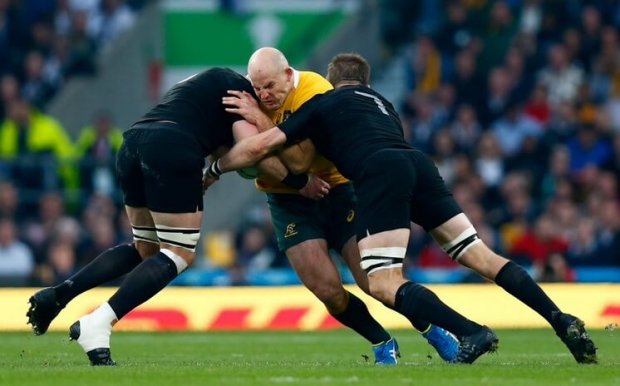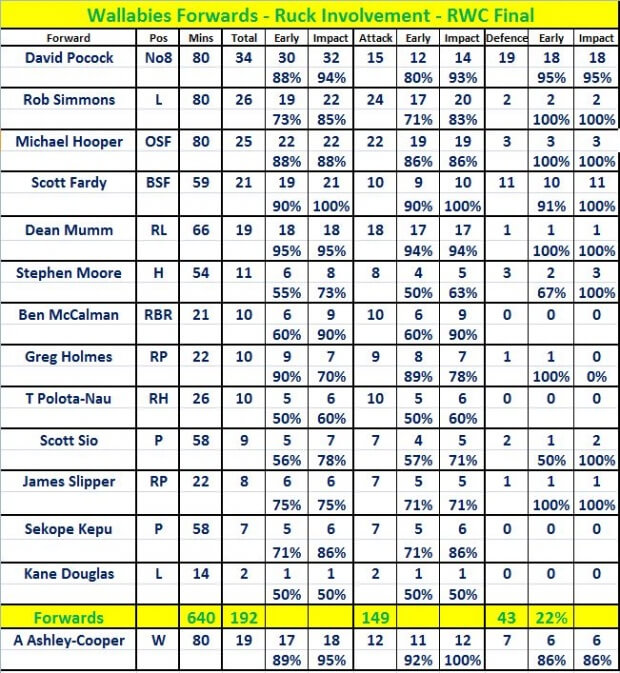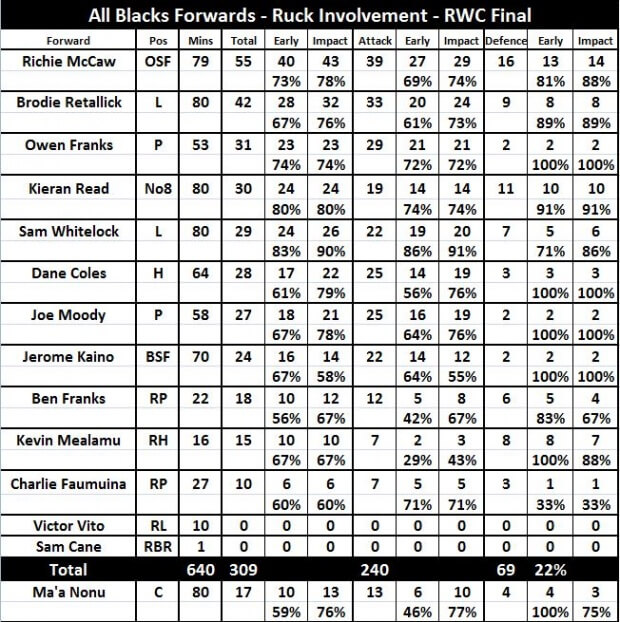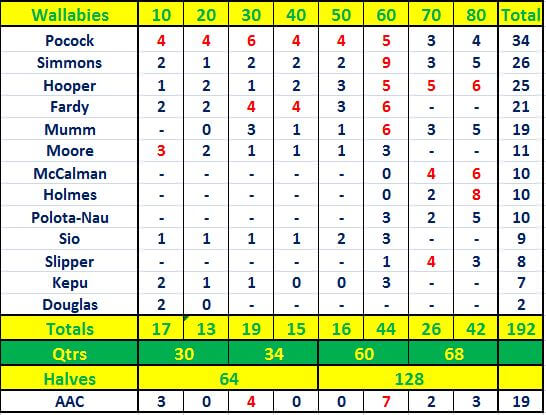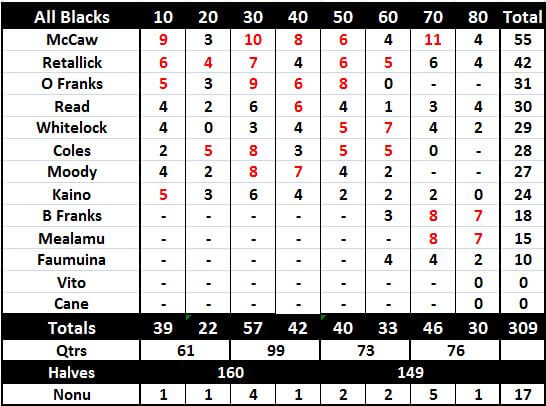Scheduled Website Maintenance
We’re currently in the process of moving to a new and improved server environment. During this transition, the website may experience brief interruptions or temporary outages.
We appreciate your patience while we complete this upgrade. Service will return to normal shortly, with improved performance and reliability.
Thank you for your understanding.
A Breakdown Master Class
Dominance at the breakdown was clearly part of the All Blacks effective game plan for victory in the RWC Final. It was a full team effort which came with intensity/muscle/commitment, speed and strong support of the All Black ball. It also came with sustained pressure on the Wallabies ball for almost the full 80 minutes. The support and pressure was maintained by flooding the breakdown with numbers at most opportunities.
My pre-game analysis concluded:
The Wallabies Forwards, particularly the Front Row and Locks (including replacements) will need to increase their work rate and ruck involvements to well above their best performances at the RWC to give the Wallabies a chance to win the Battle of the Breakdown and get their hands on The Bill.
The All Blacks clocked up more Total Ruck Involvements (309) than what they achieved against the Springboks (304) in the Semi-Final. This effort was nearly 60% above the Total Ruck Involvements of the Wallabies (195).
We saw no increase in the Ruck Involvements from the Wallabies Front Row and Locks. In most instances it was a case of David Pocock and Scott Fardy fighting gallantly against overwhelming numbers of All Blacks. Between them they provided 70% of the Defensive Ruck Involvements of the Wallabies Forward Pack. Overwhelming is the correct term to use. On only 6 occasions did the Wallabies provide ≥4 players in support of their ball carriers in rucks in attack. The All Blacks had ≥4 in ruck support in attack on 27 occasions. The remainder of the Wallabies Forwards provided the same number of Defensive Ruck Involvements as the Wallabies Backs (13). The game plan was clearly to leave the hard work to Pocock and Fardy while maintaining the defensive line.
However, the Wallabies game plan almost worked. At 64 minutes the Wallabies had fought back to be within 4 points. 10 minutes later after Dan Carter’s drop goal and long-range penalty conversion and the game was out of reach.
Congratulations to the All Blacks – they were deserved winners.
RUCK INVOLVEMENTS
Remember:
- Early means 1st or 2nd of player’s team AFTER the ball carrier has been tackled and brought to ground.
- Impact means active engagement: strong physical contact, changed shape of ruck, clean-out, protecting ball etc. (more than hand on someone’s bum or arriving after the hard work has been done). Yes it’s subjective – but as I collect all data at least it’s consistent.
- Impact DOES NOT equate to Effectiveness. I’ve concluded that coming up with an effectiveness measure is just too hard in the time that I have available – but open to suggestions.
Comments:
- The All Blacks Forwards had 117 more Total Ruck Involvements (TRIs) than the Wallabies Forwards.
- Richie McCaw’s 55 TRIs was a tournament high for those games where stats were collected. It follows on from his 53 TRIs against the Springboks.
- Brodie Retallick’s 42 DRI’s was his highest for the RWC.
- The All Blacks Front Row had and impressive 42% of the TRIs and 35% of the Defensive Ruck Involvements (DRIs). They had almost double the TRIs of their Wallabies counterparts.
- The Wallabies Front Row had 29% of Forwards TRIs and only 16% of DRIs. Only the replacements showed work rates which were above their RWC average.
- The early injury to Kane Douglas was telling as he had consistently been the most involved Wallabies Lock. Both Simmons and Mumm contributed stoically. Mumm made the equal team-high tackles (13/1).
- The Wallabies Back Row showed its usual strong contribution with nearly 50% of Forward TRIs and nearly 80% of DRIs.
- David Pocock earned another 3TOW bringing his RWC tally to 17; an impressive 3.5TOW per 80 minutes. Both Fardy and Mumm earned 2 TOW and Holmes 1TOW. In the RWC Francois Louw finished with 13TOW.
- Retallick 2TOW; McCaw 1 TOW. All Black Backs: Carter and Williams – 2TOW, Nonu and C Smith – 1TOW.
Comments:
- These numbers clearly show the All Black dominance at the Breakdown.
- Strong support for the All Black ball and 71% Possession in the 1st half resulted in 2.5x the Wallabies TRIs.
- The Wallabies doubled their TRIs in the 2nd half but were still well matched by the All Blacks.
- Wallabies fought back well in the period leading up to the Kuridrani try (63 minute) and again in the closing stages.
- The All Blacks had 2 starting Front Rowers in the top 6 for TRIs. Dane Coles had almost double his RWC average TRIs.
- The Wallabies starting Front Row all contributed well below their TWC average TRIs.
- Both teams were well served by replacements.
- AAC and Nonu were the standout Backs.
Comments:
- The Ruck Involvement stats clearly show the two very different approaches of these two top teams. Evident is the under-utilised/involved Wallabies Front Row and the over-utilised/involved Wallabies Back Row.
- Australian Rugby, at most levels, shows a fairly consistent game plan where Front Rowers rarely venture outside the central channel. The 15m outside channels are usually defended by Backs and the Back Row and very occasionally Locks. If our Forwards are a bit slow in reacting to wide attacks our outside Backs are often vulnerable with little support. IMO we don’t expect enough from our Front Row personnel.
- The All Blacks Front Row are more mobile/fitter with a more roaming brief. O Franks and Coles are often supporting ball carriers and defending in the outside channels.
- In addition, the All Black Locks show a more roaming brief and a preparedness to pounce on the isolated ball carrier.
- Both teams were intent on maintaining a strong defensive line and held off Defensive Rucks to the same extent.
- The extent to which the All Blacks were focused on ball protection is shown by the number of 3-player and ≥4-player ruck involvements. This was a clear strategy to counter the Wallabies pilferers – especially Pocock.
- Despite their minimal involvement the All Black Backs were very efficient in earning TOW.

